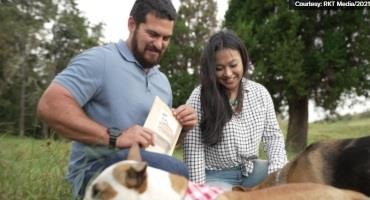Without the nest egg his grandfather had wanted for him, Vericella and his wife turned to homesteading, growing crops and raising animals to eat. They also explored creative solutions to stop the ranch from bleeding money.
“The problem is the rancher never gets to have any say in the price,” Vericella explained. “You call the broker and you say, ‘What’s the price today?’”

A third generation rancher, Nick Vericella and his wife Miki inherited a money-losing cattle ranch that they are slowly transforming into a profitable business.
It works like this: A rancher raises cows for about nine months and then sells them to a broker, who ships the animals to the mainland where they are slaughtered before they enter the beef market.
Cattle are Hawaii’s third most lucrative agricultural product, generating about $45 million in 2017, but a shortage of slaughterhouses in the islands and unpredictable market swings make it difficult for smaller operations to profit.
Hawaii is not an easy place to make a living farming.
Affordable land is hard to come by, and much of the available acreage lacks access to water or other critical infrastructure necessary to grow food.
Agricultural pests, a dire workforce shortage and the uncertainties of climate change also rank high on the long list of challenges faced by Hawaii’s food producers.
Not to mention price competition from cheaper mainland imports.
These hardships are reflected in the data. Most of Hawaii’s 7,300 farms are small farms and nearly 80% of them have annual sales under $25,000. Although U.S. Census data shows the total number of farms in Hawaii increased by about 5% to more than 7,300 from 2012 to 2017, the agricultural sector’s total market value dropped from $661 million to $564 million during the same period.
At a time when the barriers to economic success for farmers remain high, the state is pushing for more local food production — and a new generation of agricultural workers is answering the call despite the shaky economics.
“It just comes down to there’s a righteousness to it.” — James Malanaphy, Waimanalo farmer
When Vericella first took the reins of his grandfather’s ranch, he thought he was going to be rich. The broker was paying $2 a pound for his cattle that year.
The next year the price went down to $1.20. A year later, it slumped to 75 cents.
Vericella quickly learned why the ranch never made his grandfather a profit.
Eventually he and his wife seized an opportunity to turn older animals long viewed as a drain on the ranch’s profitability into the basis for a new revenue stream. With the launch of the dog food brand Pawniolo Pets in 2019, they started making money using dehydrated organs from mature cows that the ranch had historically treated as waste.
The innovation has morphed a small hobby ranch into a viable start-up business.
“I think sometimes generation-to-generation we get stuck in how our grandfather or our father did something,” said Vericella, who is 33. “I knew I couldn’t do it the same way that my grandpa did it and I knew that was OK.”
Farmers interviewed by Civil Beat who’ve launched their agricultural business in the last five years say they’re buoyed by a passion for feeding Hawaii in a more sustainable way than the status quo food system that relies on crops grown thousands of miles away. Among them are visionary 20-somethings who are just entering the workforce as well as established professionals who’ve turned to farming as a career change — one that may not offer big money but provides a chance to live more in line with their ideals.
“It just comes down to there’s a righteousness to it,” said James Malanaphy, 25, who started a vegetable farm on an eighth of an acre in Waimanalo six months ago.
“It would just be really awesome to be a steward to the land while at the same time being able to provide healthy food directly to this community and, in the end, being able to hopefully restore the land and pass it down so it can continue to be farmed by my future children,” he said.
Click here to see more...